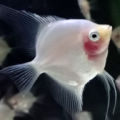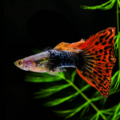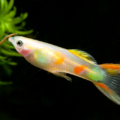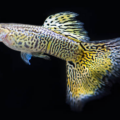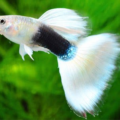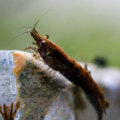Enhance your aquarium’s beauty with the colorful and aesthetic Fancy Guppy. This complete guide on caring for these bright-colored species will teach you everything from identification and feeding to health care and breeding plus much more.

Unveiling the Vibrant Charm of Fancy Guppies
Fancy Guppies are worth mentioning in the ornamental fish species Hall of Fame! This vibrant aquarium fish comes in a wide range of sub-varieties categorized based on their physical appearance.
Typically, you can distinguish a guppy by its tail shape and scale patterns, and I will show you how today. The popular guppy varieties include Delta Tail Guppies, Snakeskin Guppies, Bright-Colored Guppies, Lyretail Guppy, Dumbo Ear Guppy, Spotted Guppy, Metallic Guppy and Grass Guppy.
If you’re as starstruck with these colorful freshwater fish as I am, here’s a Fancy Guppy overview to help you take proper care of these beauties.
Quick Sidenote: Do you want to watch this article instead of reading it? Checkout the highlight video below from our YouTube Channel (Or read the more detailed article below), be sure to Subscribe For More Great Fishkeeping Content:
Distinctive Physical Characteristics
Fancy Guppies stand out for their physical characteristics, from their striking fish patterns to their unique tail shapes and sometimes colorful eyes. Adult fancy guppies are typically small fish, so they grow up to 2.5 inches, including their wide tail lengths.
Each mesmerizing feature is worth a special mention so you can better appreciate its uniqueness. So, here it goes,
Fancy Guppy Tails

The first thing you’ll notice about any Guppy is its tail shape, whether it’s dramatic or streamlined. Some popular fancy tail shapes you’ll see include the Halfmoon, Dumbo Ears, Delta Tail, Rounded, Lyretail, and Grass.
| Tail Type | Image |
| Halfmoon | |
| Dumbo Ears | |
| Delta Tail | |
| Rounded | |
| Grass | |
| Lyretail |
The Halfmoon spreads like a fan, Dumbo Ears are more elegant, like floppy elephant ears, and extend to their dorsal fin, the Delta Tail fin forms a triangular shape, and the Grass tail fin looks like plant splinters.
All these unique guppy tail shapes make up almost half of this species’ body, so it adds to their overall length.
Fancy Guppy Patterns
Hobbyists and traders also love this species for its colorful, guppy traits. Its scale colorations, which extends to its tail-fin, could be any hue on the rainbow and advanced color wheel. It could come in a solid color of basic red, yellow, or blue or have gradients and patterns.
| Scale Pattern | Fish Appearance |
| Spotted | |
| Striped | |
| Snakeskin | |
| Metallic | |
| Neon |
Some fancy guppies have the following patterns and colorations: mosaic, lace, stripes, spots, neon, two-tone, and metallic. Examples of these fancy guppies include the Cobra Guppy, Tuxedo Guppy, Endler’s Guppy, Leopard Guppy, Platinum Guppy, and Grass Guppy.
You can see more varieties in my article on the 20 popular types of guppies for your aquarium. For now, let’s focus on maintaining the Fancy Guppy appearance with the ideal water parameters as explained below.
Essential Care Requirements
Because of their delicate physical characteristics, from unique skin to small size, there are special care requirements suitable for this species. Your guppy tank setup must meet these standards:
Tank Size
Get a tank that holds a minimum of 10 gallons of water and preferably horizontal per single fancy guppy. It’ll allow your pets to swim normally without hurting their fins or getting lost in a large tank.
Water Parameters
Because fancy guppies are naturally from brackish and freshwater regions, ensure there’s a alkalinity in the water. Set the pH levels to 7 – 8, maintain a warm temperature of 72-78℉, and keep it moderately hard between 8 – 12 dGH.
We recommend using a master test kit like the one form amazon linked below to frequently test your water parameters.
Filtration
Once you stabilize your aquarium’s water parameters, add a standard filtration system to clean the water. It’s best to use a sponge or hang-on-back filter because they support slow and gentle water flow, but you can also use a compact canister filter for greater efficiency.
A single canister filter is ideal for a small 10-gallon tank, while double canisters suit larger tanks holding 50 gallons of water and more.
Don’t forget to clean your filter to prevent bacteria buildup. Filtration also helps maintain guppy health as they’re sensitive to poor water conditions, which can lead to sickness and other complications.
For more Fancy Guppy care tips, check out these ideal habitat requirements.
Creating the Ideal Habitat
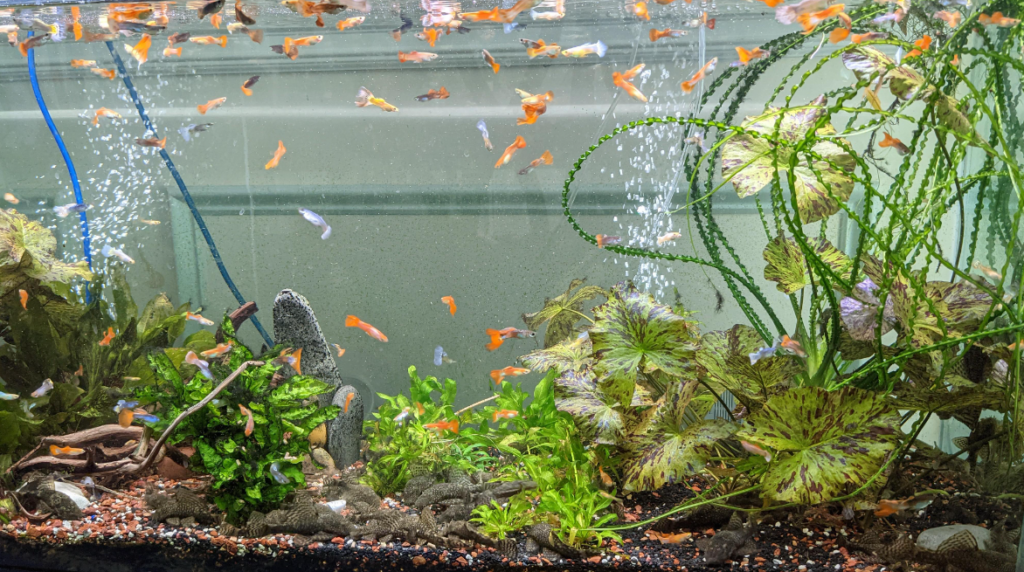
When designing your aquarium tank, use the Fancy Guppy habitat as your blueprint to help your pets grow normally.
Because they’re originally from the South American brackish waters, you should mimic its environment while adding modern touches. Whatever you do, ensure you create a guppy-friendly tank setup from the substrates to the plants, as well as other decor.
Here are some of the ways you can create the ideal habitat:
Substrate
Fine sand, gravel, smooth pebbles, and other natural-looking substrates are ideal for your fancy guppies. They’re not picky about base decor, but they need pieces that won’t hurt their skins and fancy tails.
Decoration and Plant
Some popular plants found in the Northeastern streams of South America include Java Moss, Java Fern, and Anubias. You can add them to your tank as hiding spots and aesthetic decor for your pets. Also, add rocks and driftwood to give it a realistic look.
Lighting
Use energy-saving LED lighting to create night-to-day cycles for your Fancy Guppies while also aiding plant growth.
Once you’ve got the decor and substrates for your Fancy Guppy aquarium, ensure the arrangement creates an optimal environment. Place your aquarium plants strategically over light bulbs to prevent direct reflections.
Always clean your substrates by removing leftover food and waste. If you’re wondering what kind of food fancy guppies eat, I’ve got you.
Feeding and Nutrition

Your Fancy Guppy diet should contain a mixture of different food classes and types, from live foods to frozen and plant-based foods. You can serve them commercial flakes and pellets as staples, then supplement them with other nutritious foods.
Pick foods rich in vitamins, proteins, and fats. Blanched spinach, algae wafers, and zucchini have fiber for gut health, and brine shrimps, bloodworms, tubifex worms, and daphnia are a rich protein source.
For more on feeding your aquatic pets check out The Ultimate Guide to Fish Food: Pros and Cons & Best Choices!
Feeding Schedule
Choose only food that is good for enhancing guppy color through diet and regulate their feeding frequency. Give your fancy guppies 30-40% protein, fat for energy, and calcium, but only in quantities they can finish within 3 minutes. But you can feed them that portion 2 – 3 times daily.
Health and Disease Prevention
You can do everything right for your Fancy Guppy’s health, but they’d still fall sick because of genetic predispositions. But it would be a shame if your pets get ill due to your negligence. Some common guppy illnesses caused by poor water quality include:
Ich
Symptoms: White Spots on the Body and Fins.
Treatment: Copper-based medication and Heat Treatment. Raise the water temperature to 80℉ to speed up the cycle of the bacteria causing the ailment.
For more details checkout our article on How to Treat Ich Outbreaks in Your Freshwater Fish!
Fin Rot
Symptoms: Damaged fins such as fraying, discoloration, and holes.
Treatment: Antibacterial Treatment
Velvet Disease
Symptoms: Dusty scales
Treatment: Copper-based medication and water change.
Dropsy
Symptoms: Fluid retention leading to bloating and obesity
Treatment: Antiparasitic treatment
You can trace the cause of these health diseases to poor water quality, which breeds bacteria, fungi, and other parasites. So, the best way to prevent disease is to maintain optimal water quality.
Also, maintaining wellness by pairing your pets with compatible tank mates and building the ideal habitat for their psyche goes a long way.
More fish disease management tips include quarantining new fish before introduction to the main tank, regular water changes, and observing your pets for signs of stress and distress. Consult an aquatic veterinarian if the symptoms persist.
Breeding Fancy Guppies
Do you want tips on breeding Fancy Guppies and adding more of these beauties to your aquarium without making rookie mistakes? You’d be pleased to learn that Guppy reproduction doesn’t require too many special practices, but you must follow this guideline closely.
Choosing the Breeding Pair
It can be hard to identify the male and female Fancy Guppies, but they have distinct physical characteristics. The female species are often less colorful and larger than their male counterparts.
You can identify natural breeding pairs by their courtship behavior. Watch the males and females that gravitate towards each other. The male will fan his fancy tail to attract the female’s attention when it’s time to breed.
Besides natural selection, you may also experiment with genetic selection in guppy breeding. You could discover the next unique coloration by pairing different variants.
This video has been very helpful in identifying the sex of Guppies, I highly recommend it:
Selecting the Right Breeding Tank and Condition
Get a separate breeding tank with enough flat surfaces and hiding spots for your female Fancy Guppy to birth her Fry. You can use a broad leaf or smooth ceramic saucer as a flat surface.
The ideal setup for breeding Fancy Guppies is similar to keeping the adults of this species with slight variations. Maintain the same temperature of 76-78℉ so the warmth can prep your breeding pair’s body for spawning.
The Spawning Process

Unlike other fish species, female guppies carry their young for 21 to 30 days and birth fry instead of eggs, which hatch into larvae and grow into Fry. Separate the parents from their young after birth and prepare to raise your Fry.
Raising the Fry
Raising Guppy fry is the trickiest part of breeding this species because they’re extra sensitive at this stage. Feed them infusoria and crushed powdered Fry food to boost their growth and muscle development.
As they grow larger, separate the larger Fry from the small ones so they don’t eat them. Also, get a grow-out tank to keep these larger Fry before they’re ready to join the adult tank.
If you want a community tank, you’d love the Fancy Guppies because they’re social, active, and lovers of group movements.
One concerning part of their social dynamics is the aggression males display when they feel threatened in their territory. So, always balance the ratio of males and females to avoid them competing for attention. An ideal ratio is 1:2 or 1:3, male to female.
Another trick to managing guppy interactions is pairing them with fellow peaceful species. Examples of compatible tank mates for your Fancy guppies include Corydoras Catfish and Rasboras.
Avoid fin nippers like Angelfish and other larger species with overbearing personalities.
Conclusion
I’m sure this Fancy Guppy care overview answered every question you have on caring for this peaceful, brackish/fresh water species.
Use this Fancy Guppy care summary to refresh your memory on all you’ve learned from this guide:
- Maintain a warm water temperature
- Feed your Fancy Guppies a balanced diet
- Maintain optimal water quality
- Observe your pets daily and treat illnesses immediately.
Keeping Fancy Guppies is easy when you follow this guide. You’re now ready to own your ornamental fish tank and start your journey into an enriching aquarium keeper life. Kindly share your experience with me and other aquarium lovers like you in the comments section below.



